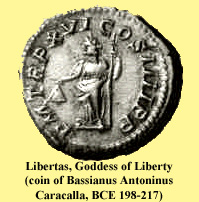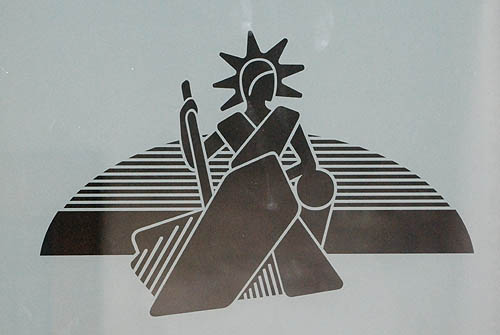
 Like
other ideals such as Truth, Justice, Prudence, Wisdom and
so on, Liberty is often personified as a woman. Such personifications
date from classical times when these qualities were personified
as goddesses. In France, whose culture is more closely linked
to the classical world, the words for such ideals are still
invariably feminine: La Verité,
La Justice, La Liberté,
etc.
Like
other ideals such as Truth, Justice, Prudence, Wisdom and
so on, Liberty is often personified as a woman. Such personifications
date from classical times when these qualities were personified
as goddesses. In France, whose culture is more closely linked
to the classical world, the words for such ideals are still
invariably feminine: La Verité,
La Justice, La Liberté,
etc.

![]() A
temple dedicated to the goddess Liberty was built on the
Aventine Hill in Rome during the second Punic War and a
statue of her was erected on the site of Cicero's house
after it had been pulled down.
A
temple dedicated to the goddess Liberty was built on the
Aventine Hill in Rome during the second Punic War and a
statue of her was erected on the site of Cicero's house
after it had been pulled down.

![]() In
France Liberty, or Liberté, is sometimes represented
as a classical goddess but she is often confused with the
personification of the French Nation, Marianne.
The figure carrying a Tricolore
and wearing a Phrygian
cap (or Liberty Cap) in the famous painting - above
left - by Delacroix (La Liberté guidant le Peuple)
is Liberté not Marianne.
The Convention at the end of September 1792 decreed that
the Seal of State should include a "Liberty figure". Modestly
attired, and now wearing a crown of seven rays, Liberté
still appears on the French
Seal of State seated and holding a fasces
in her right hand.
In
France Liberty, or Liberté, is sometimes represented
as a classical goddess but she is often confused with the
personification of the French Nation, Marianne.
The figure carrying a Tricolore
and wearing a Phrygian
cap (or Liberty Cap) in the famous painting - above
left - by Delacroix (La Liberté guidant le Peuple)
is Liberté not Marianne.
The Convention at the end of September 1792 decreed that
the Seal of State should include a "Liberty figure". Modestly
attired, and now wearing a crown of seven rays, Liberté
still appears on the French
Seal of State seated and holding a fasces
in her right hand.

![]()

![]() She
also appears on the logos of legal officers: for example
notaires (right) and bailiffs (far right)
She
also appears on the logos of legal officers: for example
notaires (right) and bailiffs (far right)

![]() Liberté
is one of the three aspirations of the French people identified
in the motto
of the French Republic as shown on the logo
to the left (which, incidentally, features Marianne,
not Liberty).
Liberté
is one of the three aspirations of the French people identified
in the motto
of the French Republic as shown on the logo
to the left (which, incidentally, features Marianne,
not Liberty).
The figure of Liberté is one of the gererally recognised symbols of sovereignty not mentioned in article 2 of the French Constitution of 1958, which refers only to le drapeau tricolore, bleu, blanc, rouge: The French Flag , L'hymne national, the national anthem, The Marseillaise and La devise de la République; the motto . "Liberté, Égalité, Fraternité". The figure personifying Liberté - or Liberty - is well known in the USA, though the fact that she is classical heathen goddess is generally played down - she is often referred to euphemistically as Lady Liberty. She is shown on a coin from 1850 on the lower right holding a Liberty Cap on a "freedom pole"

![]()

![]()

![]() A
bronze Statue of Liberty stands on top of the Capitol in
Washington (she is called Freedom rather than Liberty, but
it's the same goddess). Photographs of her are shown on
the left.
A
bronze Statue of Liberty stands on top of the Capitol in
Washington (she is called Freedom rather than Liberty, but
it's the same goddess). Photographs of her are shown on
the left.
The statue is a classical female figure of the goddess Liberty wearing her flowing robes. Her right hand rests upon the hilt of a sheathed sword. In her left holds a laurel wreath of victory and the shield of the United States. Her novel headgear is a helmet encircled by stars with a crest featuring a eagle's head, feathers and talons (a reference to the costume of Native Americans). The lower part of the base is decorated with fasces and wreaths. The bronze statue stands 19 feet 6 inches tall and weighs approximately 15,000 pounds. The crest of her helmet rises 288 feet above the east front plaza.

![]() A
statue for the top of the national Capitol had appeared
in Thomas U. Walter's original drawing for the new dome,
which was authorised in 1855. Walter's drawing showed the
outline of a statue representing Liberty. The project architect
proposed an allegorical figure called "Freedom triumphant
in War and Peace" wearing a Liberty
Cap, but Jefferson Davis (then Secretary of War) objected
to the liberty cap so the architect replaced it with an
innovative Roman helmet shown above left.
A
statue for the top of the national Capitol had appeared
in Thomas U. Walter's original drawing for the new dome,
which was authorised in 1855. Walter's drawing showed the
outline of a statue representing Liberty. The project architect
proposed an allegorical figure called "Freedom triumphant
in War and Peace" wearing a Liberty
Cap, but Jefferson Davis (then Secretary of War) objected
to the liberty cap so the architect replaced it with an
innovative Roman helmet shown above left.

![]() Austin,
Texas also has Liberty standing on top of its Capitol dome
(shown right). Unusually for the Christian southern USA
she is referred to explicitly as the Goddess of Liberty.
As on the nation's Capitol she holds a sword, this time
unsheathed. In the other she holds a lone star representing
Texas. Elsewhere in the USA she has been demoted from a
goddess to "Lady Liberty" and in some places even
further to "Miss Freedom" which some find just
a little prosaic.
Austin,
Texas also has Liberty standing on top of its Capitol dome
(shown right). Unusually for the Christian southern USA
she is referred to explicitly as the Goddess of Liberty.
As on the nation's Capitol she holds a sword, this time
unsheathed. In the other she holds a lone star representing
Texas. Elsewhere in the USA she has been demoted from a
goddess to "Lady Liberty" and in some places even
further to "Miss Freedom" which some find just
a little prosaic.

![]() A
statue of Liberty Enlightening the World which
many Americans
think of as The Statue of Liberty stands at the
entrance to New York harbour. It is because she is enlightening
the world that she carries aloft her famous torch.
A
statue of Liberty Enlightening the World which
many Americans
think of as The Statue of Liberty stands at the
entrance to New York harbour. It is because she is enlightening
the world that she carries aloft her famous torch.

![]() She
was originally designed for the Suez Canal, but eventually
commissioned as a centennial gift from the Republic of France
to the USA, a visible token of friendship between the two
republics and a symbol their shared aspirations and Enlightenment
roots. She wears the same crown of seven arches that she
does on the French
Seal of State.
She
was originally designed for the Suez Canal, but eventually
commissioned as a centennial gift from the Republic of France
to the USA, a visible token of friendship between the two
republics and a symbol their shared aspirations and Enlightenment
roots. She wears the same crown of seven arches that she
does on the French
Seal of State.
 |
 |
 |
|
Liberty outside a notaire's office |
 |
|
Liberty outside a bailiff's office |
 |




